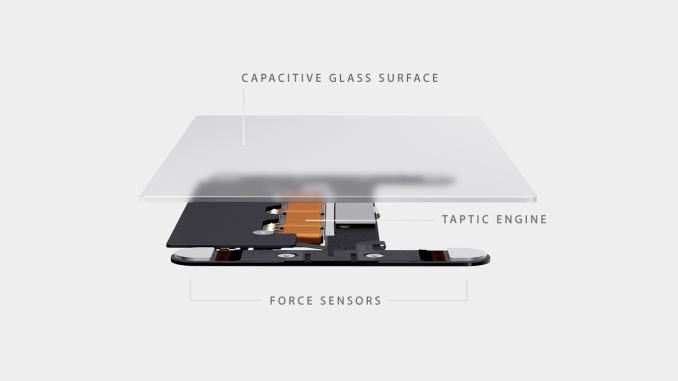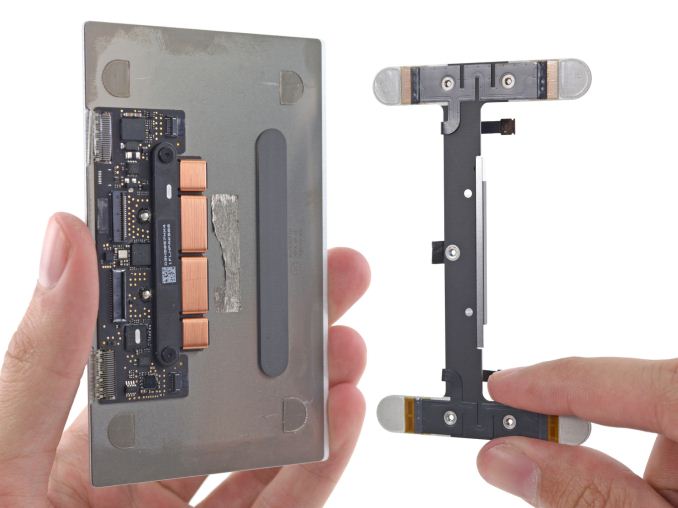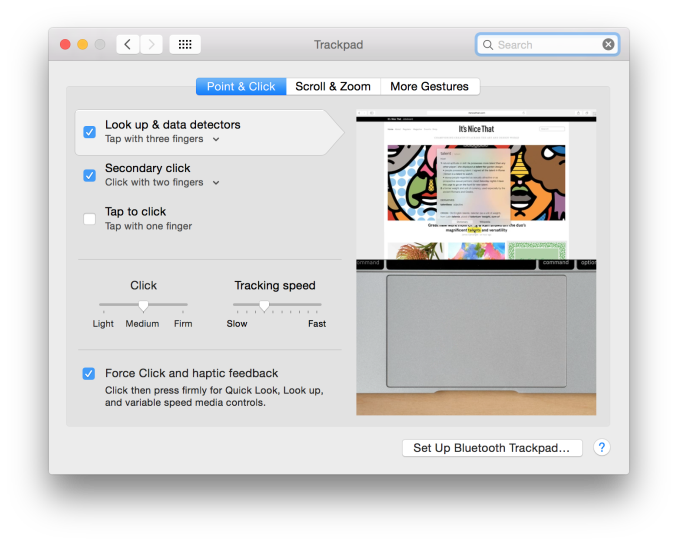The 2015 MacBook Review
by Ryan Smith on April 14, 2015 10:15 AM ESTForce Touch Trackpad
Along with Apple’s changes to their keyboard, the company has also gone in and significantly reworked their trackpad. The new Force Touch Trackpad represents the biggest change to Apple’s trackpad design since the creation of the capacitive, multi-touch pivoting trackpad introduced on the unibody MacBook Pro. In putting together the Force Touch Trackpad, Apple has significantly reworked the internals of the trackpad, creating a trackpad that behaves a lot like their traditional trackpad with some new features, but under the hood relies on some very different mechanisms.
The big change here is that Apple has done away with the traditional pivot and switch mechanism. With pivot and switch, the capacitive trackpad surface would act like a small touchscreen, and underneath it was a switch to register when the trackpad was pressed down. Mechanically the trackpad pivoted from the top (Apple likes to compare it to a diving board), with the trackpad inferring what action to take based on the combination of the capacitive readings and the switch reading. Multi-finger gestures would rely solely on the capacitive layer, primary/secondary clicks would be based on the number of fingers in use when the switch was actuated, etc.
The Force Touch Trackpad on the other hand eliminates the pivot and switch mechanism in favor of a combination of an electromagnet and force/pressure sensors. The pressure sensors essentially replace the physical switch, allowing the trackpad to tell when it has been pressed based on the amount of pressure, and thanks to the pressure sensors it can now tell how hard it has been pressed as opposed to the binary nature of the physical switch. Meanwhile without a physical switch in place to provide the clicking sensation and feedback of pressing down on the touchpad, Apple’s electromagnet – the Taptic Engine – activates to simulate the feeling and noise of pressing a switch.
Update 04/15/2015: iFixit has a great shot of the trackpad's internals, including a good look at just how big the electromagnet/taptic engine really is.
The end result is that the MacBook’s trackpad is among the first wave of devices that ships with Apple’s next generation trackpad and the enhanced capabilities that go with it. Ignoring the pressure sensitivity for a moment (we’ll get back to it), replacing the pivot and switch for an electromagnet works shockingly well. From a touch & feel standpoint the Force Touch Trackpad feels virtually identical to a traditional trackpad, to the point where it’s more than a bit uncanny. In practice you are not actually triggering a switch nor is the trackpad really moving (technically it’s deforming ever so slightly), but it sure feels like you’re working a switch. Apple has clearly done their homework on getting an electromagnet to emulate a switch, to great results. Meanwhile they don’t have the trackpad’s acoustics precisely matching a switch, but the resulting pinball-machine like plunk is close enough to a click that I don’t imagine anyone will mind the difference.
One side benefit of this change is that the trackpad feels the same throughout, and unlike the pivoting trackpad does not require more or less force depending on where you are relative to the pivot point. The variable force required has never been a major problem in my experience, but it is nice to no longer need to worry about where your fingers are relative to the top, and consequently how much force you need to use.
However the bigger deal is that by making the amount of force required to click consistent throughout the entire trackpad, Apple can now use the amount of pressure applied as another input, making the trackpad pressure-sensitive. The underlying pressure sensors and electromagnet are by default programmed to have two levels of feedback – a shallower press is equivalent to a click – and a deeper press brings about the pressure-sensitive “Force Click.” What force clicking does depends on the application, and right now it’s clear that Apple is still experimenting with what they can do with pressure sensitivity. The most obvious uses include line thickness in drawing applications, but the company is also using it for things such as variable speed fast forward and rewinding in QuickTime/iMovie. At times the force click is treated like a 3rd (tertiary) click, and other times the result is based on variable pressure. Since this is a new (and uncommon) feature there’s no global action assigned to the force click – nor does it behave as a middle click on a regular mouse – so what happens is up to the application.
In implementing force click and the Force Touch Trackpad, Apple does offer the ability to control the amount of pressure required and whether force click is active. With force click deactivated the trackpad behaves more or less identical to a traditional trackpad with a single click level. Meanwhile the click pressure setting is interesting, though I’m not entirely convinced it’s all that effective. Short of the tools to actually measure click pressure, I’m not so sure Apple is changing the amount of pressure required to trigger a click so much as they’re changing how hard the electromagnet vibrates. The feedback change is certainly very subtle going from light to firm, and if there is a change in the amount of pressure required then it is certainly equally subtle.
Ultimately whether the Force Touch Trackpad is a major upgrade or not is going to depend on a user’s ability to make use of the force click features. Even turned off, the new trackpad is essentially an improved version of the old trackpad without the minor drawbacks of the pivot mechanism. But with the force click turned on, then it brings new (though not always useful) actions to the trackpad that in turn makes it a bigger upgrade over the old trackpad.
In any case, the MacBook along with the 2015 MacBook Pro 13” are the first wave of devices to implement the new Force Touch Trackpad. Given its expanded capabilities I would expect Apple to eventually replace many (if not all) of their trackpads with this new design. Certainly the 15” MacBook Pro is a likely candidate, as is a future version of the Magic Trackpad. What remains to be seen is whether the next MacBook Air also gets this new trackpad, or if Apple withholds it to keep the products differentiated and to keep the costs of the MacBook Air down.














354 Comments
View All Comments
TEAMSWITCHER - Friday, April 17, 2015 - link
The $1599 - 1.2GHz - 512GB model is ~5K, in Geek Bench 3.The "Actual Work" comment cracks me up. I have successfully done 3D web-plugin development for a major company on an 11" MacBook Air. I'm pretty sure I could have done the same thing with a 12" MacBook...probably even a little better.
milkod2001 - Monday, April 20, 2015 - link
3D web-plugin development could probably be done on entry level laptop :). By actual work i've meant working with many layers, exporting to high rez tiffs, pdf, a bit of video production on the go etc.This is not where new MAcbook will serve very well. That's for less then 5% of potential Macbook buyers though, so im sure many(including you) will be more then happy with this new Macbook.
vampyren - Thursday, April 16, 2015 - link
This is just a shitty laptop, underpowered, useless with one port.Apple should have added the screen, keyboard, touch-pad on Air and everyone would been happy.
There is a limit to how thin you can make things before they become useless.
I love my MBP and was going to get the updated Air had they added retina on it but they sadly made a useless version instead.
hummerchine - Thursday, April 16, 2015 - link
I'm constantly amazed at some of the fervid anti-Apple comments on this and other forums! This review was fantastic and right on...the best I've seen, and I've been seeking them out (AnandTech does a great job, as did this reviewer). The new MacBook is highly desirable for the right person...that would be me. I've ordered the best, most tricked-out model. Is it a desktop replacement? It was not intended to be! If you want a desktop with more power, or even a portable with more power...Apple and many other companies offer many other options. If you want a crazy light awesome travel computer, this is as good as it gets! The complaints about performance just blow my mind. They have crammed in the best processor, screen, keyboard, trackpad, batteries, whatever you can mention into the smallest and lightest laptop human beings can currently design. And some are whining about it? Jeez...just think about what you are saying! And if you really hate Apple's operating system so bad (my personal favorite, but I can see that is personal preference) there are competing Windows products with the same technology limitations. If you are like me and like Apple's OS, just how could they have possibly made this thing any nicer? Well...they probably could have squeezed in another USB C port or perhaps a small MagSafe connector. I suppose even more RAM might have been nice. A faster processor would be nice too...but isn't the Intel Core-M the fastest processor currently available that will fit into something so small, have good battery life, and not require a fan? Come to grips with reality some of you...that review was very accurate and well done, and I can't wait to get my new laptop! The millions of buyers of these things don't have to listen to you...they vote with their wallets! Btw, I'm very pleased to also be a stockholder.kdalkafoukis - Friday, April 17, 2015 - link
Does anybody knows any real performance details like?how many open pdfs can u have for example?
or
in which kind of programms you are gonna have problems(annoying performance)?
cgpublic - Friday, April 17, 2015 - link
I checked the new Macbook at the Apple Store. I'm a marketing professional with a a 2011 MBP 15" quad-core, 2012 MBA entry-level, and a the latest Mac Mini w/i7 dual-core in my toolkit. Apple is once again ahead of the curve, which is what they can afford to do, while other manufacturers have to design to ensure they don't leave any checkboxes unchecked. Which is why companies such as Dell are who they are, and Apple is choking on cash. People will pay good money for a taste of the future, and this is the future right here.For 95% of what I do, the Macbook Core M + good WiFi signal can manage with ease. Photo-editing can be done in a pinch w/Adobe CreativeCloud. Once you pick it up, you have to have it, and everything else is yesterday's news.
If you're primarily playing games and fapping on your PC, I guess processing power and wired connectivity is a big deal, but I earn for a living, in the real world.
tecsi - Saturday, April 18, 2015 - link
Prediction: the new MacBook will shortly outsell the 11" MBA, the 13" MBA and the 13" rMBP. Why? Dramatically better than both MBAs and priced about the same when configured with 8TB RAM and 256GB SSD. Half the weight of the rMBP, cheaper and with most of the feature set of the except for CPU speed. But for those notebook users that need performance, they will jump to 15" rMBP with its max performance.tecsi - Saturday, April 18, 2015 - link
Make that 8GB RAM, not 8TBtecsi - Saturday, April 18, 2015 - link
Two items not really clearly mentioned, but one crucial and another useful via-a-via the MBAs.First, and most important, I find I can productively use the MacBook display at 1920x1280 (with SwitchResX). This offers 266% of the screen real estate of the 11" MBA, an enormous, work-changing difference.
Second, but more minor, the new MacBook's Trackpad is ~25% bigger than the 11" MBA, providing easier, more accurate cursor movement and positioning.
jameskatt - Sunday, April 19, 2015 - link
The fact that Apple's slowest Macbook has the fastest SSD performance means the next Macbook Pro 15-inch Retina Update is going to HAVE A BLAST with huge unencumbered SSD speeds. Coupled with a 2 TB size increase and hopefully 32 GB RAM and 4K screen, this bar will move up further.